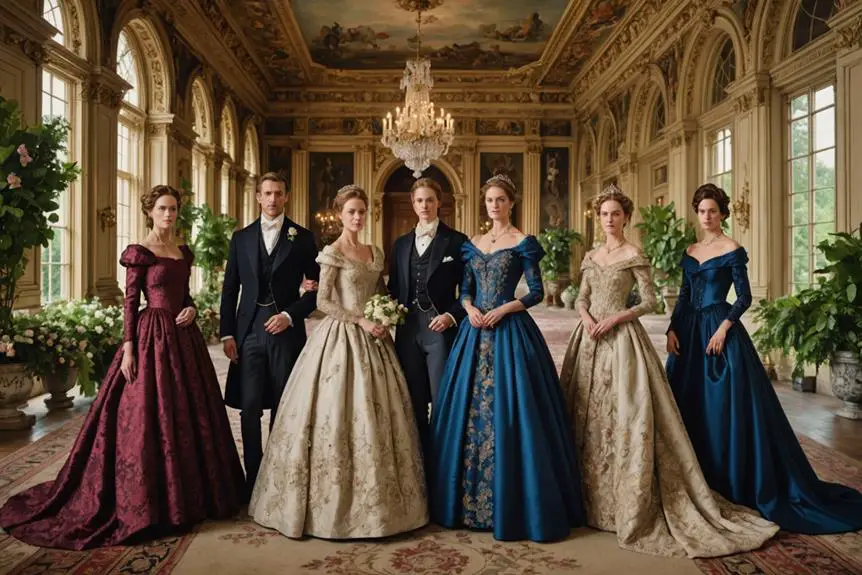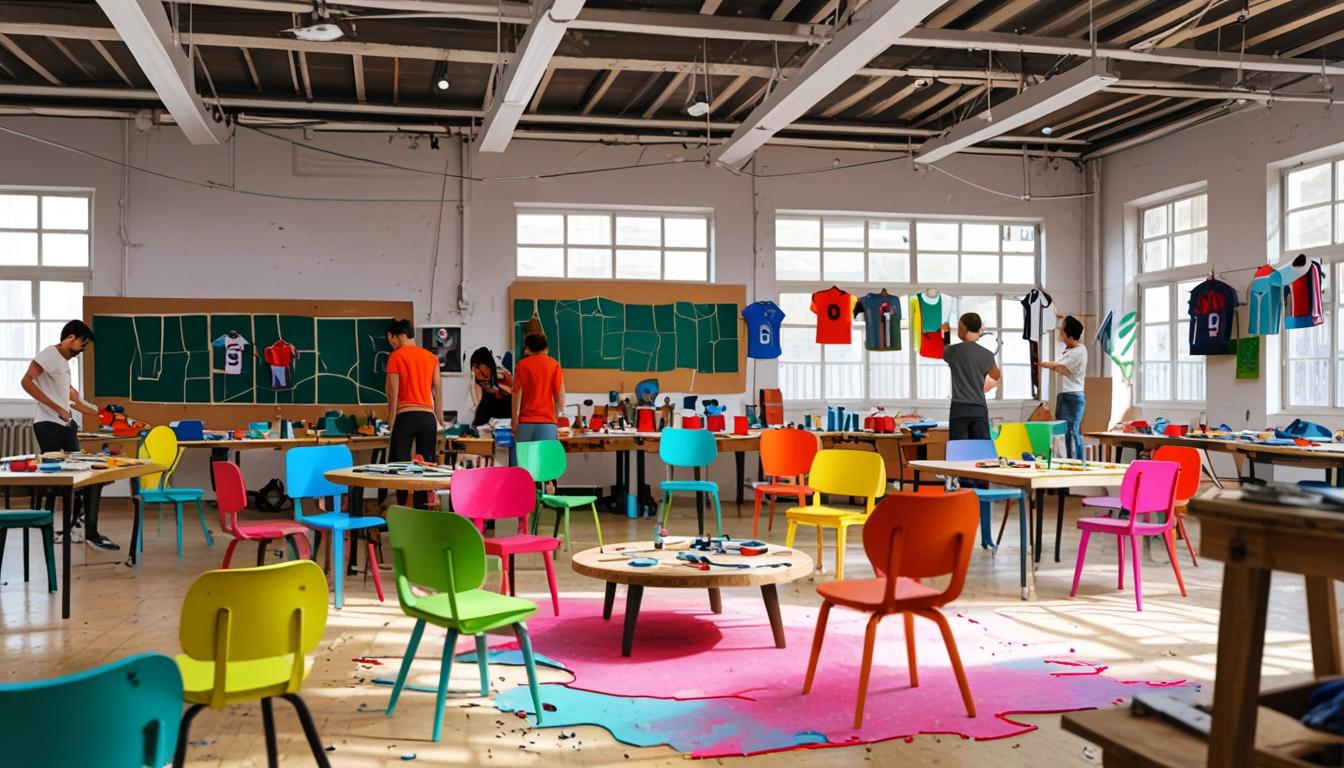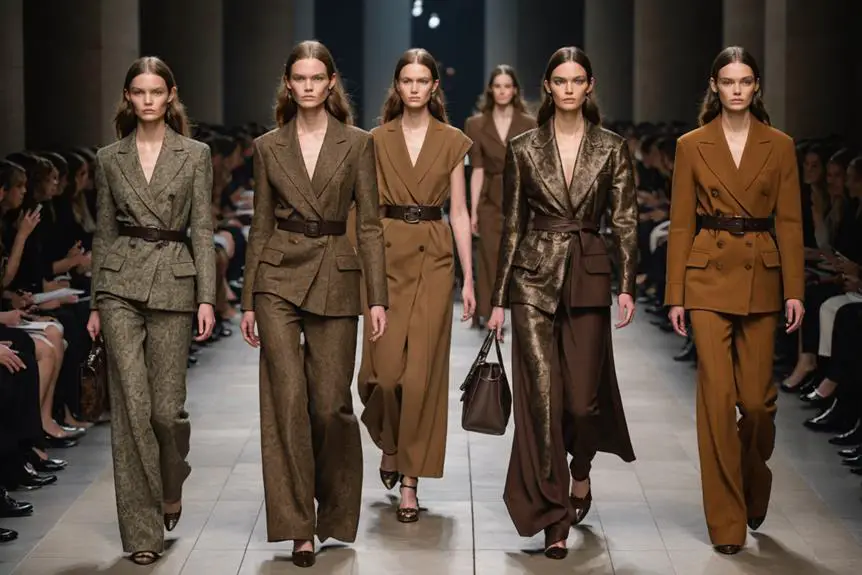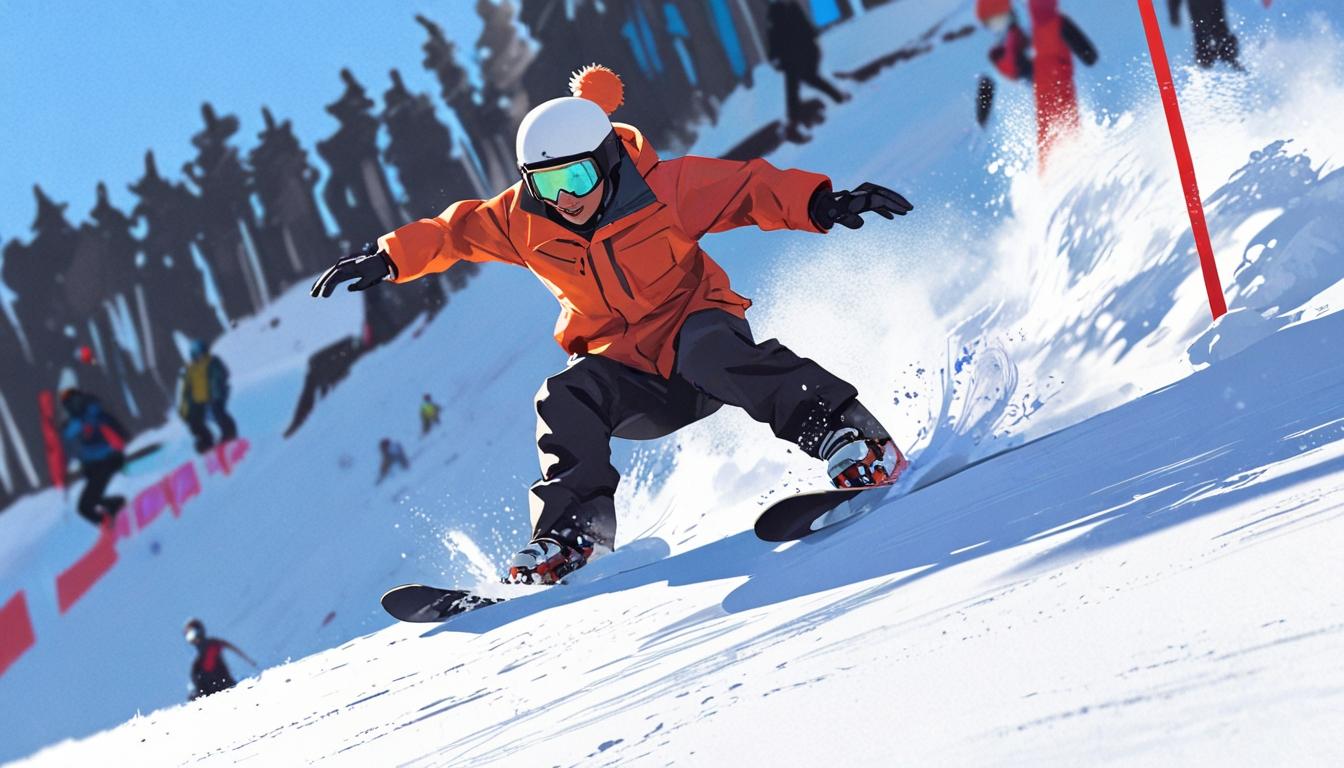When you look at the outfits in "Victoria & Abdul," you can't help but notice how they reflect the characters' evolving relationship. Consolata Boyle's designs not only capture historical accuracy but also convey deeper emotional shifts, especially in Queen Victoria's wardrobe. Her change from dark, somber attire to vibrant colors speaks volumes about her growing bond with Abdul. Meanwhile, Abdul's clothing transformation highlights his cultural identity and rising status. But what do these choices really reveal about the film's underlying themes of power and cultural exchange?
Overview of Costume Design
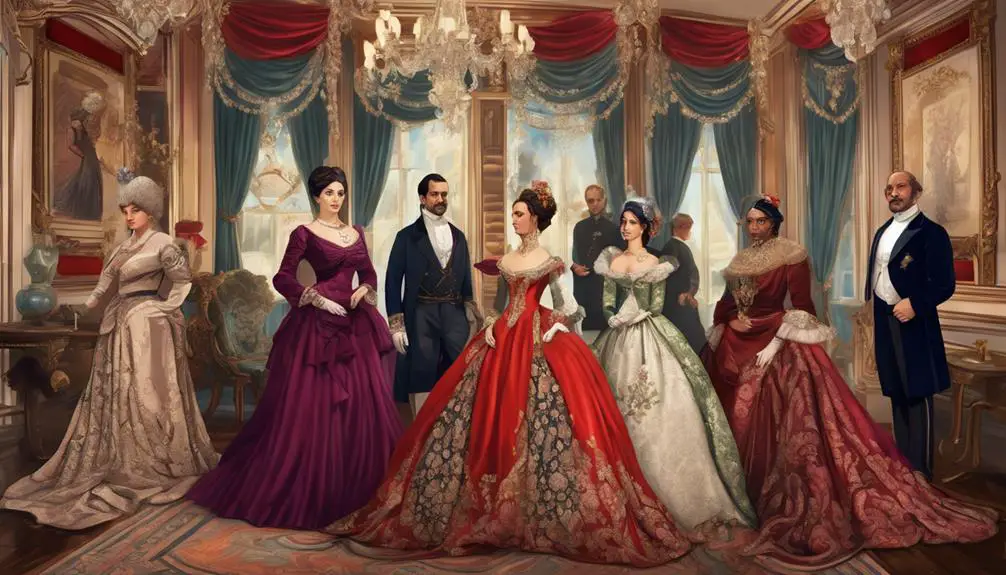
In "Victoria & Abdul," the costume design plays an essential role in bringing the historical narrative to life. You'll notice how every piece of clothing tells a story, right? Costume designer Consolata Boyle really nailed it by diving into royal archives and examining preserved gowns from Royal Palaces. She made sure the outfits were historically accurate, which is super important for a film set in the Victorian period.
Take Queen Victoria's wardrobe, for example. Most of her dresses are in black, reflecting mourning customs, but Boyle also gives her a color palette that shifts as Victoria's emotions change. It's like her outfits have their own personalities!
Now, let's talk about Abdul Karim. At first, his clothes are simple and Westernized, but as he gains more importance in the royal household, his attire evolves into vibrant traditional Indian garments. This shift in clothing beautifully mirrors the changing dynamics of their relationship.
And can we talk about the details? Boyle uses heavy embroidery, lace, and rich dark tones to add depth to the costumes. These embellishments make you feel like you're stepping right into the Victorian era. Plus, the collaboration between Boyle and actress Judi Dench makes Queen Victoria feel more authentic. You can really sense how costumes play a huge role in character development and storytelling. So, next time you watch, pay close attention to those outfits—they're more than just fabric; they're a window into the past!
Queen Victoria's Wardrobe Choices
Queen Victoria's wardrobe choices reveal a complex interplay of mourning, emotion, and status. Her costumes mainly featured black garments, a reflection of the mourning customs she adhered to after the death of her beloved husband, Prince Albert. Can you imagine wearing black for 40 years? That's a long time! As you watch the film, you'll notice how Victoria's costumes gradually shift to dark grays, purples, and browns, mirroring her evolving friendship with Abdul Karim. It's like her wardrobe tells a story of hope and healing.
The costume designer, Consolata Boyle, really nailed the vibe of the Victorian era with heavily embellished fabrics, intricate embroidery, and delicate lace. These details not only look stunning but also highlight the opulence of her royal life. Each piece, especially the jewelry designed by Albert, adds layers to her personal history and mourning narrative. Those sparkling jewels? They carry a lot of emotional weight!
But it's not just about beauty; the elaborate and heavy gowns Victoria wore represent her physical and emotional constraints. They show how, despite her royal status, she felt vulnerable within the confines of the palace. Isn't it fascinating how fashion can symbolize so much? So, as you immerse yourself in Queen Victoria's world, remember that her wardrobe choices are more than just costumes—they're a window into her heart and mind. What do you think her outfits say about her journey?
Abdul Karim's Attire Evolution
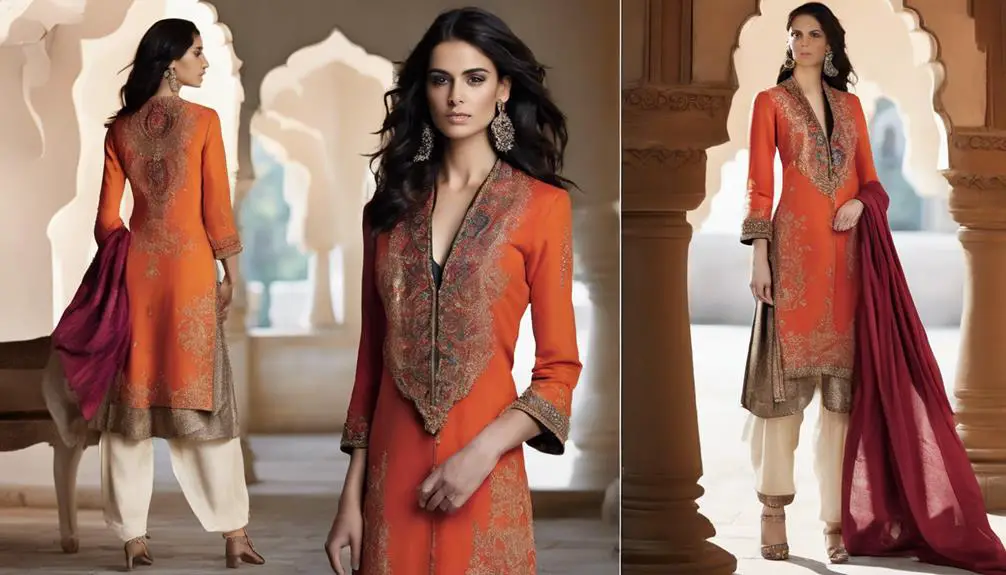
Abdul Karim's attire tells a compelling story of transformation and cultural fusion within the royal household. At first, you'd notice him in simple, Westernized servant uniforms. They were practical but pretty dull, right? However, as Abdul's relationship with Queen Victoria blossomed, so did his costumes. He began swapping those basic outfits for rich, traditional Indian garments that reflected his rising status, much like the evolution of vintage Ralph Lauren that showcases cultural significance in fashion.
Imagine the vibrant colors and intricate embroidery! His clothing became more elaborate, showcasing luxurious silks that celebrated his Indian heritage. This alteration wasn't just about looks; it symbolized the cultural clash between British formality and Indian vibrancy. You could really see the complexities of his identity unfolding right before your eyes in the royal court.
Plus, the designers did an amazing job incorporating traditional Indian textiles into Abdul's uniforms. The royal crest even made an appearance, blending British imperial symbolism with those gorgeous Indian aesthetics. Talk about a unique position in the monarchy!
As you watch the film, pay close attention to those costumes. They're not just clothes; they're a visual representation of Abdul's journey and the rich tapestry of cultures colliding within the royal household. How cool is it to think that clothing can tell such a powerful story? So, what do you think? Would you rock those outfits if you had the chance?
Symbolism in Costume Choices
When you look at the costumes in "Victoria & Abdul," you can really see how they tell a story about cultural identity and emotional journeys. Isn't it fascinating how Abdul's outfits shift from simple to vibrant, showing his rising importance? Plus, Queen Victoria's heavy dresses reflect her struggles and the weight of being a monarch, making you wonder how fashion can reveal so much about power dynamics!
Cultural Identity Representation
In "Victoria & Abdul," the costumes serve as a powerful visual narrative, capturing the evolving dynamics of cultural identity between the two main characters. You can really see how their friendship grows through what they wear! Abdul Karim starts off in plain Western-style uniforms, reflecting his initial place in the royal household. But as his status rises, he begins to don those stunning traditional Indian garments. Isn't that a cool transformation?
Now, check out Queen Victoria's wardrobe. It's mostly black at first, fitting for the Victorian Era's mourning customs. But as her bond with Abdul deepens, she starts to add more vibrant colors. This shift symbolizes her growing acceptance of cultural diversity. The contrast between Abdul's colorful outfits and Victoria's darker attire shows the cultural clash between their worlds.
You'll notice that Abdul's costumes evolve from Western perceptions of servitude to showcase the beauty of Indian craftsmanship. This illustrates his journey toward identity and autonomy. So, next time you watch, pay close attention to those costumes! They tell a story all on their own, celebrating the rich tapestry of friendship and cultural identity.
Emotional Journey Visualization
Queen Victoria's emotional journey is vividly illustrated through her evolving wardrobe in "Victoria & Abdul." As the narrative unfolds, you'll notice her shift from deep blacks, emblematic of mourning, to richer hues like greens and purples. This change in costumes beautifully reflects her growing friendship with Abdul and the changing tides of her heart.
Each outfit she dons carries emotional weight. The heavy embellishments and textures in her attire symbolize the royal responsibilities she bears, almost like a crown of expectations. You can feel the constraints she faces, can't you? Meanwhile, Abdul starts off in simple, Westernized clothing, but as their bond deepens, his costumes transform too. Those vibrant, traditional Indian textiles he wears symbolize not just his rising status but also the warmth of their friendship.
The use of dark colors in their costumes highlights the emotional depth and complexity of their relationship. It sets the stage for moments of vulnerability, showcasing how their friendship flourishes amidst the challenges of a royal household. Isn't it fascinating how costumes can tell such a powerful story? Each outfit truly helps you connect with Victoria and Abdul's incredible journey!
Power Dynamics Reflection
Costume design in "Victoria & Abdul" powerfully illustrates the shifting dynamics of their relationship, highlighting the contrasts between royal authority and emerging influence. You can really see how the power dynamics play out in their costumes. Queen Victoria wears heavy, elaborate garments that show her royal status, but they also show the constraints she faces. It's like wearing a crown made of lead! Meanwhile, as Abdul's status rises, he moves from simple Western clothing to vibrant Indian attire. This change isn't just about fashion; it's a visual narrative of his growing influence.
The dark colors and rich textures in Victoria's wardrobe reveal her emotional depth and the weight of her position. They hint at her mourning and fragility. The costumes also showcase a cultural clash between the rigid formality of British royalty and the expressive vibrancy of Indian textiles. This tension adds complexity to their friendship. As their outfits evolve, they symbolize respect and connection, breaking down barriers of class and culture. It's amazing how a simple piece of clothing can tell such a powerful story, right? It makes you appreciate the art of costume design even more!
Cultural Clash Reflected in Fashion
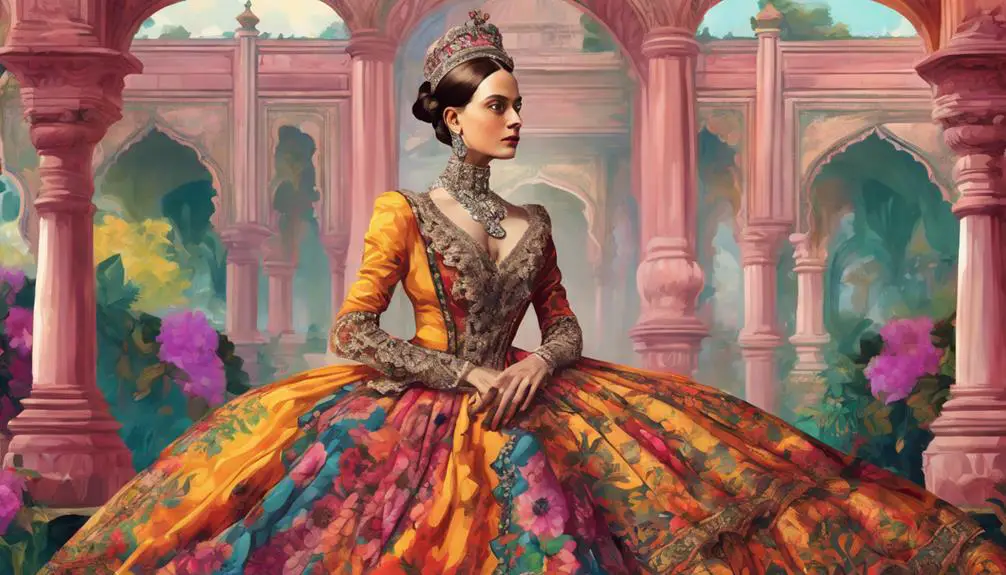
As the story unfolds, the costumes in "Victoria & Abdul" vividly illustrate the cultural clash between British and Indian identities. You can't help but notice how the film's wardrobe highlights the stark differences between the formal attire of the English royal court and the vibrant textiles of Indian culture. It's like a fashion showdown!
Check out these key costume contrasts:
- Abdul's Transformation: He starts off in Westernized servant attire but quickly shifts to flashy Indian clothing as his status rises. Talk about a glow-up!
- Queen Victoria's Palette: Her costumes often feature mourning colors like deep blacks, moving to dark greens and purples. These colors reflect her emotional journey, especially with Abdul around.
- Exotic Embellishments: Abdul's costumes boast rich silks and intricate designs, emphasizing the British court's perception of exoticism. It's both beautiful and complicated.
- Cultural Appropriation Tension: The costumes for both Abdul and Victoria reveal the struggles for identity and acceptance during the late Victorian period. Isn't it interesting how clothing can tell such a complex story?
The film's costumes don't just serve as eye candy; they embody the cultural clash and the merging of two worlds. So, next time you watch "Victoria & Abdul," pay close attention to the outfits. They're not just clothes; they're a reflection of history, emotion, and the challenges of blending cultures!
Collaboration With Actors and Designers
The intricate relationship between actors and designers plays a significant role in bringing a film's vision to life, especially in "Victoria & Abdul." Costume designer Consolata Boyle formed a close partnership with Dame Judi Dench, which fostered a creative environment that influenced the portrayal of Queen Victoria. Can you imagine how much a costume can shape a character? Boyle and Dench really understood that.
Boyle emphasized open communication with actors, knowing that experienced performers like Dench have a unique grasp of how costumes add depth to their characters. They had lots of discussions about historical accuracy and the emotional impact of each outfit. This teamwork was essential in creating costumes that truly represented Queen Victoria's character and her journey throughout the film.
Each character's attire was meticulously crafted, reflecting their identity and relationships. As the story unfolded, you could see how the costumes evolved, showing the character's growth and changes. Isn't it fascinating how clothing can tell a story all on its own?
The collaboration between Boyle and Dench was all about making sure every costume felt authentic and resonated emotionally. By adapting costumes to fit the character's evolution, they highlighted the importance of teamwork in achieving stunning costume design. So, next time you watch "Victoria & Abdul," pay close attention to those costumes. They're not just clothes; they're a crucial part of the storytelling magic!
Impact on Character Development
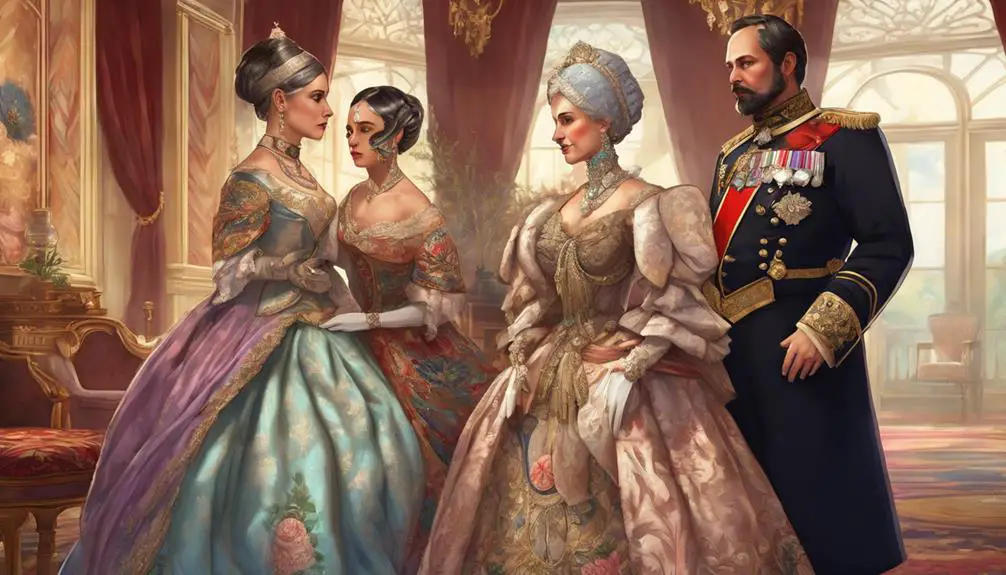
When you watch "Victoria & Abdul," it's hard not to notice how the costumes tell an amazing story about the characters. Queen Victoria's shift from heavy black dresses to colorful outfits really shows her emotional journey as her bond with Abdul grows. Plus, the way Abdul's clothes change from simple to flamboyant highlights his rising status and confidence—who knew outfits could say so much?
Visual Storytelling Through Costumes
Through the intricate use of costumes in "Victoria & Abdul," you can see how visual storytelling powerfully impacts character development. The costumes do more than just dress the characters; they reveal their feelings and growth throughout the film. Here's how:
- Queen Victoria's Transformation: Her shift from deep black mourning attire to vibrant colors mirrors her emotional journey as she opens up to Abdul.
- Physical Constraints: Victoria's elaborate costumes symbolize the societal expectations weighing her down, showcasing her vulnerability.
- Abdul's Rising Status: Watch how his costumes evolve from basic Western uniforms to rich Indian garments, reflecting his increasing importance in the royal court.
- Cultural Clash: The heavy embellishments and textures in Victoria's wardrobe highlight the complexities of her relationships, emphasizing the cultural clash and friendship that develop.
These costumes act as a narrative device, pushing the story forward while helping you understand the characters better. You're not just watching; you're feeling their struggles and triumphs. So, next time you see the film, pay attention to how those outfits tell their stories!
Emotional Journey Reflected
Costumes in "Victoria & Abdul" vividly reflect the emotional journeys of the characters, showcasing their growth and struggles. You can really see Queen Victoria's transformation through her outfits. At first, she wears deep blacks that symbolize her mourning. As her friendship with Abdul deepens, her costumes shift to varied dark tones, representing her emotional journey and the complexities of her royal status. Those heavy embellishments and rich textures? They show just how trapped she feels, caught between duty and desire.
Now, let's talk about Abdul. His clothing evolves too! He starts off in simple Western attire, but as he gains confidence and his status within the royal household rises, he dons stunning traditional garments. This switch really mirrors his personal growth and newfound self-assurance.
The elaborate dressing scenes highlight Victoria's physical limitations, hinting at her need for support. By the time you reach the final banquet scene, the costumes encapsulate the emotional resonance of their bond. You can feel the tension and warmth of their friendship, making you wonder: isn't it amazing how costumes can tell such powerful stories?
Power Dynamics Illustrated
In "Victoria & Abdul," the power dynamics between the characters are vividly illustrated through their costumes, revealing the complexities of their relationship. You can really see how Queen Victoria's heavy black mourning garments symbolize her emotional constraints and societal expectations. It's like her wardrobe is holding her back! On the flip side, as Abdul Karim's status evolves from a simple clerk to a trusted confidant, his costumes change from Western attire to vibrant Indian clothing. This shift highlights his rising influence and the changing power dynamics in his friendship with Victoria.
Here are four key points to think about:
- Victoria's Costumes: They reflect her passivity and limitations, emphasizing her royal protocol.
- Abdul's Attire: His colorful garments showcase his cultural identity and growing autonomy.
- Visual Storytelling: The costumes tell a tale of tension between British authority and Abdul's individuality.
- Final Scenes: Both characters in their cultural outfits symbolize the culmination of their unique friendship.
Frequently Asked Questions
What Materials Were Primarily Used in the Movie's Costumes?
When it comes to costume design, you've got to contemplate the fabric choices, color palettes, and texture details. Accessory significance and layering techniques play an essential role in bringing characters to life on screen.
How Did the Costumes Reflect the Historical Accuracy of the Period?
The costumes reflect historical accuracy through their attention to fashion evolution, capturing cultural significance. They enhance character development and provide visual storytelling, immersing you in the historical context and making the period come alive.
Were Any Outfits Inspired by Real-Life Historical Garments?
Yes, many outfits draw from historical influences, showcasing character symbolism and cultural representation. Designers focused on fashion accuracy and design evolution, ensuring the garments reflect the era's authenticity while conveying deeper meanings about the characters.
How Did the Weather Influence Costume Choices During Filming?
When the sun blazes or rain pours, your costume choices shift dramatically. Weather conditions dictate fabric choices, while seasonal variations and climate adaptations guarantee you stay comfortable and authentic across diverse filming locations.
Did the Costume Budget Affect the Overall Design Process?
Yes, the costume budget definitely shapes the design process. You'll find that budget constraints influence costume creativity, encouraging collaboration among designers to select a cohesive color palette that enhances character representation while staying within financial limits.
